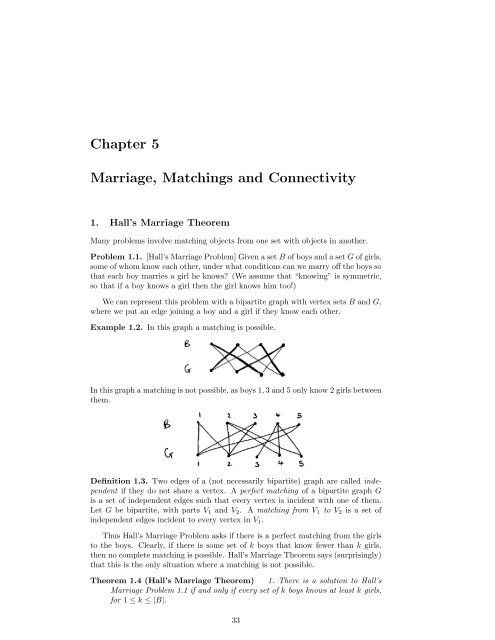You also want an ePaper? Increase the reach of your titles
YUMPU automatically turns print PDFs into web optimized ePapers that Google loves.
Chapter 5Marriage, Matchings and Connectivity1. Hall’s Marriage TheoremMany problems involve matching objects from one set with objects in another.Problem 1.1. [Hall’s Marriage Problem] Given a set B of boys and a set G of girls,some of whom know each other, under what conditions can we marry off the boys sothat each boy marries a girl he knows? (We assume that “knowing” is symmetric,so that if a boy knows a girl then the girl knows him too!)We can represent this problem with a bipartite graph with vertex sets B and G,where we put an edge joining a boy and a girl if they know each other.Example 1.2. In this graph a matching is possible.In this graph a matching is not possible, as boys 1, 3 and 5 only know 2 girls betweenthem.Definition 1.3. Two edges of a (not necessarily bipartite) graph are called independentif they do not share a vertex. A perfect matching of a bipartite graph Gis a set of independent edges such that every vertex is incident with one of them.Let G be bipartite, with parts V 1 and V 2 . A matching from V 1 to V 2 is a set ofindependent edges incident to every vertex in V 1 .Thus Hall’s Marriage Problem asks if there is a perfect matching from the girlsto the boys. Clearly, if there is some set of k boys that know fewer than k girls,then no complete matching is possible. Hall’s Marriage Theorem says (surprisingly)that this is the only situation where a matching is not possible.Theorem 1.4 (Hall’s Marriage Theorem) 1. There is a solution to Hall’sMarriage Problem 1.1 if and only if every set of k boys knows at least k girls,for 1 ≤ k ≤ |B|.33













